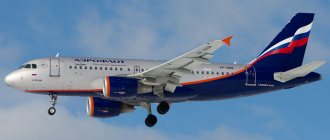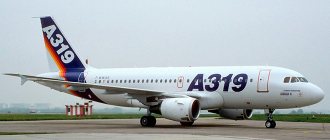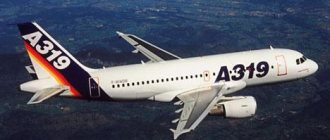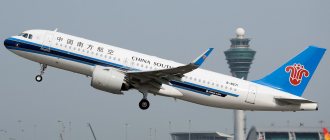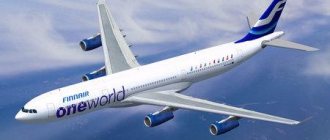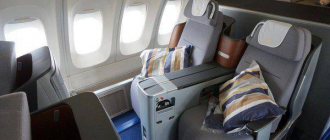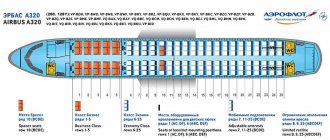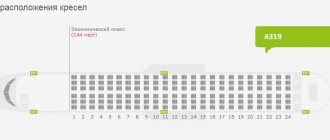| Aeroflot I Fly Nordwind Turkish Airlines Reviews |
The wide-body airliner Airbus A330 (Airbus A330) is used for medium and long-distance flights and has been produced since 1992.
The most common modifications in the fleets of Russian airlines are the Airbus A330-200 and A330-300. Capacity - from 253 to 440 passenger seats, depends not only on the modification (on the A330-200 the fuselage is shortened by almost 6 meters), but also on the cabin layout, which is determined by the airline.
The world's largest operator of Airbus A330 aircraft is Turkish Airlines. In Russia, these aircraft are operated on some regular flights of Aeroflot and Nordwind Airlines, and on I Fly charters.
Economy class cabin at Nordwind Airlines © nordwindairlines.ru
Photo of Airbus 330-300
In the first class cabin
A330-300 cockpit
Aircraft A330-300
Interior modifications
The outstanding characteristics of the long-haul aircraft Airbus a330 300 make it an indispensable aircraft for long-haul passenger transportation.
There are three modifications of the interior with different degrees of comfort. The most common modification is to divide the aircraft into two classes: standard and improved seats, business and economy class, respectively. This aircraft can carry up to 335 passengers.
Next comes the division into three classes - first, business and economy. Capacity - up to 295 people. There are also solid economy class airliners. Such an aircraft is capable of carrying up to 440 passengers.
Diagram of the Airbus 330-300 aircraft on Aeroflot lines: the best and worst seats
The Russian airline uses 17 A300-330 aircraft on its flights. The main difference is the number of seats in the business compartment: it is 36 (in 1 aircraft), 34 (in 5) or 28 (in 11).
The most common option provides that 5 rows are allocated for the business salon. The 28 seats are arranged in a 2-2-2 configuration, with the exception of the last row with a 2-2 layout.
If you are in the business section, the journey will be comfortable in any case. The seats here can be reclined 180˚ and you can relax peacefully. True, the 1st and 5th rows are located close to the buffet, so passengers are sometimes disturbed by noise and food smells.
Selecting seats in economy class Airbus 330-300
Rows 11-45 are reserved for economy class with the main seat arrangement being 2-4-2. The exceptions are the following:
- In the 28th and 29th there are only 4 chairs.
- 42-45 a 2-3-2 pattern.
The best options on board the Airbus 330-300 are considered 30C and 30H . They are located near the emergency exit, so you get extra space and stretch your legs.
According to passenger reviews, seats 29D, E, F and G . They will appeal to tall travelers, but, unlike previous options, they have disadvantages. After all, the chairs are located near the toilets, and you will be disturbed by passengers scurrying past. But if you're traveling with a baby, you'll love the accessibility of bassinets.
The bad options on the Airbus 330-300 on Aeroflot lines include the following rows:
- The 11th is located close to the restrooms and buffet. You will be bothered by unpleasant odors and increased traffic. There are also fastenings for bassinets nearby: there is a risk that a naughty baby will be nearby.
- The 27th and 28th are located near the restrooms. The seat backs do not recline completely or are fixed.
- In the 41st, seat D is considered bad. Due to the fact that the salon begins to narrow behind it, there are no seats behind it. For this reason, passengers returning from the restroom touch the back of the seat.
- 44 is considered a failure due to the proximity of the toilets. The exception is 44F , because the chair is far from the aisle.
- 45 is the worst option in the Airbus 330-300 cabin. It's located near the restrooms, so you'll have to put up with a line inside. The seats do not recline, and you will not be able to sleep peacefully on the plane.
All passengers on the Airbus 330-300 are offered in-flight entertainment, with Panasonic eX2 monitors offering more than 70 movies and TV programs. There are also power outlets and USB ports; Wi-Fi is available on some ships.
Accidents and disasters
As of February 26, 2022, a total of 11 Airbus 330 aircraft were lost as a result of accidents and serious accidents[35]. They tried to hijack an Airbus 330 twice, resulting in the death of 1 person[36]. A total of 339 people died in these incidents.
| date | Board number | Disaster site | Victims | Short description |
| 30.06.1994 | F-WWKH | Toulouse | 7/7 | Test flight. Crew errors during engine failure simulation. |
| 15.03.2000 | 9M-MKB | Kuala Lumpur | 0/266 | Chemical corrosion of the fuselage during the illegal transportation of dangerous goods. Decommissioned. |
| 17.03.2000 | C-GGWA | Vancouver | 0/n.d. | During takeoff, debris that was not cleared from the runway was sucked into the engines. |
| 25.05.2000 | F-OHZN | Antipolo | 1/291 | Attempted hijacking. Having received the ransom, the hijacker jumped out of the plane and died. |
| 13.10.2000 | n.d. | Malaga | 0/158 | Attempted hijacking. |
| 04.12.2000 | n.d. | Bujumbura | 0/170 | During landing he came under fire from the rebels. |
| 24.07.2001 | 4R-ALE | Colombo | 0/0 | Destroyed as a result of an attack by the Tamil Tigers on the airport. |
| 24.07.2001 | 4R-ALF | Colombo | 0/0 | Destroyed as a result of an attack by the Tamil Tigers on the airport. |
| 24.08.2001 | C-GITS | Terceira | 0/306 | Made the longest glide of any jet due to a jet fuel leak. |
| 27.12.2001 | PT-MVB | Zurich | 0/n.d. | While being towed, it collided with an Avro RJ.100 Crossair. |
| 29.08.2005 | N855NW | Portland | 0/247 | While taxiing to the runway, it collided with a DHC-8. |
| 04.10.2007 | D-AERK | Dusseldorf | 0/125 | During takeoff, the engine was destroyed and aviation fuel leaked. |
| 07.10.2008 | VH-QPA | Indian Ocean | 0/315 | During a planned flight, he made two spontaneous dives due to a technical malfunction[37]. |
| 01.06.2009 | F-GZCP | Atlantic Ocean | 228/228 | Fell off the train due to erroneous actions of the crew due to incorrect readings from icy speed sensors. |
| 25.12.2009 | N820NW | Detroit | 0/290 | Attempted explosion. The hijacker detonated a bomb and was injured; the plane made an emergency landing. |
| 13.04.2010 | B-HLL | Hong Kong | 0/322 | Failure of both engines due to contamination of jet fuel. |
| 12.05.2010 | 5A-ONG | Tripoli | 103/104 | Crashed during landing in thick fog due to crew errors. |
| 17.12.2010 | OD-MEA | Paris | 0/n.d. | The tugboat lost control and took the plane in the wrong direction. |
| 13.04.2011 | F-GZCB | Caracas | 0/215 | Hard landing in harsh weather conditions. |
| 10.08.2012 | D-AIKE | Washington | 0/n.d. | While taxiing, he collided with a DHC-8. |
| 01.05.2013 | LN-RKO | Newark | 0/242 | Collided with an ERJ 145 on the taxiway. |
| 08.09.2013 | HS-TEF | Bangkok | 0/302 | Rolled off the runway due to a broken landing gear. |
| 07.10.2013 | RP-C3336 | Manila | 0/214 | It caught fire shortly after passengers disembarked. |
| 24.12.2013 | G-VNYC | Vieux Fort | 0/32 | Almost rolled off the runway when landing in the rain. |
| 29.06.2014 | 9M-MUC | Astana | 0/2 | Cargo flight. Damaged the wing when it collided with a lamp post while taxiing to the runway. |
| 15.07.2014 | 5A-LAS | Tripoli | 0/0 | Destroyed by a rocket during the fighting at the airport. |
| 20.07.2014 | 5A-ONF | Tripoli | 0/0 | Burnt down during the fighting at the airport. |
| 04.03.2015 | TC-JOC | Kathmandu | 0/235 | The front landing gear collapsed. Rolled off the runway. |
| 14.03.2015 | 9M-MTA | Melbourne | 0/n.d. | Hard landing. Received minor damage and restored. |
| 28.08.2016 | HL8258 | Seoul | 0/0 | Sustained damage to both horizontal stabilizers while being towed. |
| 01.10.2016 | B-18307 | Taipei | 0/137 | During landing, the tail part touched the runway. |
| 27.11.2017 | G-VRAY | NY | 0/n.d. | While taxiing to the runway, it collided with a Boeing 777. |
| 18.04.2018 | N806NW | Atlanta | 0/288 | Shortly after takeoff, engine No. 2 caught fire. |
| 13.05.2018 | HL7792 | Istanbul | 0/n.d. | While taxiing to the runway, the wing cut off the stabilizer of the A321. |
| 21.05.2018 | TC-OCH | Jeddah | 0/n.d. | After landing, the front landing gear collapsed. |
| 26.06.2018 | HL8286 | Seoul | 0/0 | Collided with a Boeing 777 while taxiing. |
| 31.10.2018 | F-GZCI | Paris | 0/n.d. | The tips of the wings collided. |
| N817NW | 0/n.d. |
Airbus 330-300 on Lufthansa lines
The cabin plans used by Lufthansa are available in 3 versions:
- 8 first class compartments, 30 business seats, 21 premium economy seats and 177 economy seats;
- 8 passengers travel in first class, 42 in business class, 21 in premium economy, 145 in economy;
- 42 seats are located in the business compartment, 28 in the premium economy compartment, 185 in the economy compartment.
If you are traveling on an Airbus 330-300 in first class, please pay attention to the rules for selecting tickets:
- First class seats are arranged 1-2-1. Either option will be a winner, although in the 1st row you will be concerned about the proximity of the buffet and restrooms.
- The business compartment has 3-12 rows with 2-2-2 seats. The 10th is considered unsuccessful because it is located next to the toilets.
- The seats in the Premium Economy (2-3-2) have improved dimensions: 96.5 cm in length and 45.7 cm in width compared to the standard ones. But 34 will be a disappointment, as you'll get less legroom due to the proximity of the bulkhead.
- The economy sector includes rows 30 to 46, with seats 43.1 cm wide and 78.7 cm long, arranged according to the 2-4-2 and 2-3-2 principle. The best option is considered to be 30 , since due to the proximity of the emergency exit you will get additional legroom. The disadvantages include the fact that there is a toilet nearby. In addition, pull-out tables are attached to the arms of the chairs, which affects the width of the seats.
- 41D, E, G are considered unsuccessful , since the seats are inconveniently located in relation to those in front. Try not to end up on 40D or 40G : there are no seats behind them, so passengers returning from the restroom often hit the backrests.
- Avoid seating on 46 , it is next to the toilet. The backs of the seats will be fixed, and you will not be able to relax comfortably.
Take these subtleties into account, choose your seats on the Airbus A330-300 in advance, and there will be no unpleasant surprises.
Reviews of the Airbus 330-300 on Lufthansa lines
07/22/2017, the passenger was flying at 40 H
Once on board the Airbus 330-300, I saw that the seats in rows 40-46 were narrower than the rest in economy class. This should be marked in red on the interior diagrams! The flight was simply terrible.
05/07/2018, the passenger was flying on 26A
I decided to treat myself to premium economy and did not regret it: the dimensions of the chair exceeded my expectations. The space became smaller when the passenger in front reclined his seat. But everything was better than in economy class! I liked both the food and the service. I think the money was well spent.
Airbus A 330-300: cabin layout on Lufthansa flights without premium class
The airline also uses a ship with 3 classes of service. Rows 1-11 on this aircraft are dedicated to the business compartment; the seats are arranged in a 2-2-2 configuration. With all the advantages of this option, try to avoid seating in the 1st, 5th (except 5A and 5K) and 10th rows, as they are located near toilets or service areas.
Premium Economy occupies rows 15-19 ; The seats are arranged in a 2-3-2 pattern. 15th is considered the best option , since the legroom is increased. Seats with the letter E will be an unsuccessful solution: you will be between other passengers, and you will not be able to get up without disturbing them.
If you find yourself in the economy compartment, look for the following on the diagram:
- 22D, E, F, G;
- 23A, C, H.
Since there are no other seats in front of these seats, you will be able to stretch your legs. This plus is accompanied by disadvantages: the retractable table and monitor are mounted on the armrest. As a result, it becomes fixed, and the width of the seat decreases.
Controversial variants on board the Airbus 330-300 include row 29, 30C and 30H . Although the legroom allows you to sit comfortably, the proximity of the toilet will cause discomfort. Places 30A and 30K , since the nearby emergency exit door will interfere with you.
It is not advisable to sit on 41D, E and G (the location in relation to the seats in front may be inconvenient), as well as 40D and 40G. The 46th row on the Airbus 330-300 is traditionally considered unsuccessful due to the fixed backrests of the seats.
Reviews of flying Airbus 330-300 with Lufthansa (3-class cabin)
On 10/03/2018 the passenger was flying on 18A
I have already traveled with Lufthansa and appreciated the convenience of Airbus. I like the upgraded economy compartment because I get comfort at an affordable price. But this time the trip was a disappointment! It turned out that if the passenger sitting in front reclines the back completely, it is impossible to get out of my seat. Going to the toilet became a hassle, which ruined the experience.
Notes
Comments
- ↑ An airplane has 375 seats if it has 3 “type A” doors and 1 “type 1” door. If the plane has 4 “type A” doors, then the number of seats is 406.
- ↑ An airplane has 375 seats if it has 3 “type A” doors and 1 “type 1” door. If the plane has 4 “type A” doors, then the number of seats is 440.
Sources
- ↑
- ↑ 1 2 3 (undefined)
. Airbus.com (13 January 2014). Retrieved June 1, 2014. February 3, 2014. - ↑ (English). Airbus. Retrieved March 15, 2022.
- ↑
- ↑
- ↑ "." Flight International
. 14 March 2006. - ↑ Kingsley-Jones, Max. . Flight International
, 4 August 2009. - ↑
- ↑ (undefined)
. Retrieved July 21, 2010. February 15, 2012. - ↑ "dated February 21, 2009 on the Wayback Machine." Airbus
. 17 August 2006. - ↑ (undefined)
. ATW Online (August 16, 2010). Retrieved August 16, 2010. February 15, 2012. - ↑
- ↑
- ↑
- ↑ February 16, 2012.
- ↑ (unspecified)
(inaccessible link). Retrieved February 14, 2022. March 29, 2015. - ↑ November 3, 2012.
- ↑ (unspecified)
(inaccessible link). Retrieved July 17, 2012. July 12, 2012. - ↑ (Russian), AVIADO.RU - Portal about aviation and cheap air tickets
. Retrieved February 11, 2022. - ↑
- ↑
- ↑
- ↑ October 20, 2014.
- ↑ Kingsley-Jones, Max (unspecified)
.
Flightglobal
(20 May 2010). Retrieved October 7, 2013. - ↑. Airbus.com (2 December 2013). Retrieved on December 9, 2013.
- ↑ (inaccessible link)
- ↑ (undefined)
. Airbus SAS Retrieved November 20, 2012. - ↑ (undefined)
. Airbus SAS Retrieved November 20, 2012. - ↑ (unspecified)
(PDF) 42–51. Airbus SAS (1 January 2014). Retrieved July 6, 2014. - ↑ (undefined)
. Airbus SAS Retrieved November 20, 2012. - ↑ (undefined)
. Pratt & Whitney. Retrieved April 30, 2011. March 19, 2012. - ↑ 1 2 (undefined)
. EASA (22 November 2013). Retrieved May 16, 2014. - ↑ (undefined)
(PDF) 1–3. Federal Aviation Agency. Retrieved March 5, 2011. - ↑ Frawley, Gerald.
Airbus A330-200″, “Airbus A330-300 // The International Directory of Civil Aircraft, 2003/2004. - Fyshwick, Australia, 2003. - ISBN 1-875671-58-7. - ↑
- ↑
- ↑
Airbus 330-300 Turkish Airlines
Turkish Airlines uses the model on international flights. Capacity is 289 passengers: 28 in business class and 261 in economy class.
To find the best seats on the Airbus A330-300, consider the following:
- 1–5 are reserved for business class , and passengers are not recommended to sit in the first and last. There is a restroom and a buffet nearby, which can ruin the flight experience.
- In economy class (rows 6–40), rows 6 and 24 , because the proximity of the emergency exit allows you to get additional space.
- The unlucky seats include the entire 22nd and 23rd row: the backs of the seats recline only partially or are fixed.
- You won't like the 36D, E and F , because there's not much legroom. In seats 35D and F, passengers complain that other travelers bump into the backs of their seats.
- The worst options are the entire 40th row, 38A, B, J and K. The proximity of restrooms and fixed seat backs will ruin your flight. You shouldn’t board 12A or 12K : there are no portholes next to them.
By choosing your seats in advance, you can travel in comfort.
Reviews of the Airbus 330-300 on Turkish Airlines
05/20/2018, the passenger was flying on 12A
After landing, it turned out that there was no window next to my seat. I was upset because I couldn’t take spectacular photos. Otherwise, the comfort was not satisfactory, and the 3-hour flight went by unnoticed. All seats in economy class have small monitors so you can watch a movie. But the headphones turned out to be terrible, and next time I'll bring my own from home. The food was okay, although there's nothing to really praise about it. But the service was excellent: the pilot welcomed everyone on board, and the staff were friendly.
Flight performance
| A330-200 | A330-200F | A330-300 | |
| Crew | Two | ||
| Passenger capacity, typical | 253 (3-class)293 (2-class)375: (optional) 406 | 295 (3-class) 335 (2-class) 375: (optional) 440 | |
| Length | 58.82 m | 63.69 m | |
| Wingspan | 60.3 m | ||
| Wing area | 361.6 m² | ||
| Wing extension | 10.06 | ||
| Sweep angle | 30° | ||
| Keel height | 17.39 m | 16.90 m | 16.83 m |
| Cabin width | 5.28 m | ||
| Seat width | 18″ (457 mm) with 8-row standard economy or 16.5″ (419 mm) with 9-row high-density economy | ||
| Fuselage width | 5.64 m | ||
| Cargo volume | 136 m³ | 475 m³ 70 t / up to 12 accompanying people[24] | 162.8 m³ |
| Maximum take-off weight (MTOW) | 242,000 kg (530,000 lb) | 233,000 kg (510,000 lb) | 242,000 kg (530,000 lb) |
| Maximum landing weight | 182,000 kg (400,000 lb) | 187,000 kg (410,000 lb) | |
| Functional dead weight (typical) | 119,600 kg (264,000 lb) | 109,000 kg (240,000 lb) | 124,500 kg (274,000 lb) |
| Cruising speed | 0.82 M (871 km/h at 11,000 meters (36,000 ft) flight altitude) | ||
| Maximum cruising speed | 0.86 M (913 km/h at 11,000 meters (36,000 feet) flight altitude) | ||
| Maximum range when fully loaded | 13,400 kilometers (8,300 mi) | 7400 kilometers (4600 miles) 65t5950 kilometers (3700 miles) 70t | 11,300 kilometers (7,000 miles) |
| Take-off run at MVM (sea level, MSA, Rolls Royce Trent 772B engines[25]) | 2,770 m (9,090 ft) | 2580 m (8460 ft) | 2,770 m (9,090 ft) |
| Maximum fuel charge | 139,090 l | 139,090 l | 139,090 l |
| Flight altitude | 12,527 m (41,100 ft) | ||
| Maximum height | 13,000 m (42,651 ft) | ||
| Engines (×2)(see below) | General Electric CF6-80E1 Pratt & Whitney PW4000 Rolls-Royce Trent 700 | Pratt & Whitney PW4000 Rolls-Royce Trent 700 | General Electric CF6-80E1 Pratt & Whitney PW4000 Rolls-Royce Trent 700 |
| Traction (×2) | PW: 70,000 lbf (311 kN) RR: 71,100 lbf (316 kN)[26]GE: 72,000 lbf (320 kN) | PW: 70,000 lbf (311 kN) RR: 71,100 lbf (316 kN) | PW: 70,000 lbf (311 kN) RR: 71,100 lbf (316 kN) GE: 72,000 lbf (320 kN) |
About the manufacturer Airbus
Airbus, which produces this type of aircraft, is one of the largest in the world. Its competition with aircraft manufacturer Boeing has continued for decades with varying degrees of success. As for the A330-300 model, it turned out to be more in demand than similar airliners B767 and B787.
The European company began operations in the 1960s, the result of a merger of several manufacturers. At the request of the governments of Great Britain, France and Germany, she began to develop a model that was supposed to displace the Boeing-727 from airlines. The result was the A300, the world's first wide-body twin-engine airliner. A successful flight took place in 1972, and 2 years later mass production began. But within a few years, a need arose for more spacious aircraft, which was the reason for the creation of the Airbus 330-300.
Features of the A330-300 model: what you need to know about the aircraft
The airliner, released as a replacement for the classic A300, has a lengthened fuselage. As a result, passenger capacity increased:
- with 1st class of service, the aircraft cabin can accommodate 440 passengers and crew;
- for 2 classes the capacity is 335 people;
- If the plane has 3 classes of service, 295 passengers can fly on board.
The flight range is 10,800 km, and it is achieved without compromising payload capacity. A combination of factors allowed the aircraft to successfully compete with similar aircraft produced by Boeing.
Airbus 330-300 modifications
In addition to the A330-300 version, the following variations have been released:
- The A330-300HGW was first announced in 2000. The manufacturer announced that it was working on strengthening the wing, increasing payload capacity and additional fuel tank capacity. The aircraft was put into operation in 2015, and the first company to use the aircraft was Delta Airlines.
- The A330-300 Regional was announced in 2013 with a capacity of 400 passengers. According to the manufacturer, maintenance costs for this variation are reduced by 26% compared to the main one.
In general, the A330-300 aircraft is part of the wide A330 family, which includes civil and military aircraft.
Production and sales of Airbus 330-300 to Russia
The production of components for the models is carried out in France, Germany and the UK. The parts are then shipped by air or ground. The airliners themselves, already fit for flight, are assembled in France, but at this stage they need interior finishing. It is produced in Hamburg, after which the planes fly to Toulouse. Subsequently, they are sent to customers, including Russian carriers: Aeroflot (22 aircraft) and charter ]I Fly[/anchor] (2 aircraft).
Prospects
Currently, a new aircraft, the A330neo, is being developed based on the A330-300 airliner. According to the announcement, the aircraft will have:
- own power plants;
- improved aerodynamics;
- Large, in comparison with the base model, wingspan and area.
Passengers on the new plane will have separate cabins. The creators promise a number of other surprises. The A330neo will appear soon on European and Australian airlines. It is possible that Aeroflot will not want to lag behind and will purchase a couple of such “superliners”.
Where is the airliner made?
The launch of mass production of the Airbus A330 put forward new demands on factories. Companies responsible for the supply of individual elements had to invest large amounts of money. British Aerospace, which produces wings, needed to upgrade its production facilities at a cost of £12,000,000, with its total project costs exceeding £450,000,000. Germany's MBB had to spend $255,000,000 to upgrade its factories and begin producing parts of the required quality on time.
The largest production costs were incurred during the creation of the Airbus assembly site in Toulouse, France. A total of $411,000,000 was invested in it. The final assembly of the A330 takes place here. Some items are produced locally, but many are shipped from other countries by ship or aircraft.
Design
Since at one time the airliner was supposed to compete with the Boeing 787-9 and 777-200, it was created taking into account the latest Airbus developments at that time and filled with modern technical solutions.
Engines currently used include Rolls-Royce, General Electric and Pratt & Whitney. Part of the body is made of composite materials, making the model lighter than previous representatives of the series. Flight control is carried out by the Fly-by-Wire digital system, the cockpits are equipped with LCD displays, and the steering wheels are replaced with joysticks. The A330-300 is designed to cover a distance of approximately 11,000 kilometers. Therefore, there are comfortable, well-thought-out areas for crew rest on board. Flight attendants can use a separate cabin compartment or spend time in a equipped area in the cargo hold.
Equipped with two engines, the aircraft is considered the largest in its family (read about other aviation giants here). The length of 63.69 meters allows you to transport up to 440 people per flight, providing the necessary level of comfort and enough personal space. The vessel is characterized by an enlarged luggage compartment, low noise level on board, a different layout dividing the cabin into classes, and 2 wide aisles between the seats.

